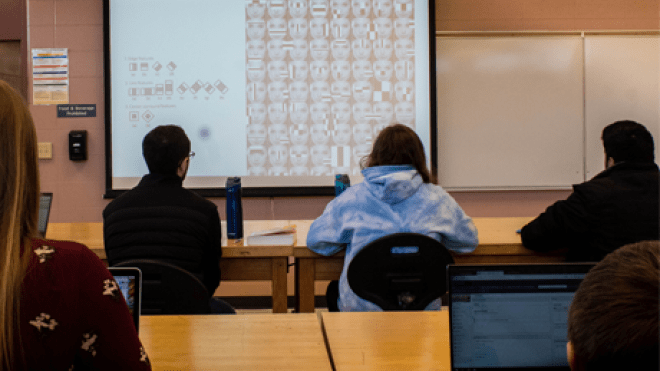Prepared to Design Future Technologies: Students Study How to Build Computer Systems to Think for Themselves
In this computer science course, students gain hands-on experience in building computer systems using the same tools and techniques implemented by industry professionals

BRISTOL, R.I. – Have you ever wondered how your cell phone unlocks just by using your face? How is it able to detect the difference between your face and someone else’s? This feature, now prominent in most cell phones, is just one type of machine learning that RWU students are learning how to build. In a computer science course, students went behind the screen to learn how facial recognition computer systems are constructed and how this type of technology can be applied to future devices.
“Instead of writing a program to recognize faces by defining what eyes are, what a nose is, you can show a computer a lot of pictures of faces and have it learn what a face is by itself,” Cates said. “What I teach are very basic techniques but they are related to what would be going on behind the scenes in something like a self-driving car or any other automated technology that uses images.”
The course, COMSC 415: Machine Learning taught by Professor Sonya Cates, teaches students how to build computer systems that learn from data to make predictions, recognize patterns and organize information. Students are introduced to supervised and unsupervised machine learning, identify classification problems and are trained to use the tools and techniques that are implemented in the industry.
It's important for students today to learn how to make these data-driven computer systems because they're used for much more than allowing your face to unlock your phone. They protect us against credit card fraud and spam emails. They allow Amazon Alexa to speak to us and are one of the key components in building self-driving cars.
For Abigail Small, a junior applied mathematics and computer science double major, being able to expand her previous data science knowledge and also learn what is going on behind the programs will be largely beneficial to her future studies. Furthermore, being able to study machine learning during her undergraduate career she says has given her an advantage when applying to graduate schools.
“I hope to continue with research in mathematical modeling with applications in the life sciences. The use of analyzation of data is not only a very important aspect of that field, but it’s the primary focus of machine learning,” Small said. “Machine learning is primarily taught to graduate students so we, as undergraduates are at such an advantage being able to go into the work-field or graduate schools and already have the ability to program these technologies.”
In addition to building spam email filters and facial recognizers, the students have conducted projects in which they are applying theory to real-world practice. They classified celestial objects as either stars or quasars based on light spectrum data and have determined if movie reviews on the popular website IMDB are positive or negative based on classification standards they construct from scratch.
“For each of them, I get to apply the models discussed in the lecture and relate them to real case studies and real-life applications. I’m learning the theory and then get to use that information to actually create those models on a real data set,” said junior computer engineering major Jessica Jensen.
These projects have taught Jensen how to analyze results and extract meaningful information as well as give her hands-on experience in constructing real-world models. And because machine learning is such a broad field and can be applied to many different disciplines, she says this course will be critical to her future work as an engineer and researcher.
“There are a lot of applications for machine learning and companies are desperate for people who know how to do these things,” Cates said. “From social media posts, purchasing history, medical histories, all these things help companies to learn about their customers, to be able to make predictions and to better promote their products, all of which are heavily dependent on machine learning ideas.”